Greetings from Heidelberg, Germany
by Robert Tucker
Reprinted from "Crown Jewels of the Wire", April 2001, page 11
"Bon Jour."
"Bon Jour Sylvie".
"Syndia, Comment-allez
vous?"
"Je vais bien. C'est possible nous venons aujourd'Hui?"
And the conversation went on, with me not understanding more than just the
intonation. But I could tell this inquiry was going well by the smiles on
Syndia's face.
"Au revoir. Merci beaucoup".
"Well," I
blurted out, "Do we go?"
"Hold on bucko. They have looked at the
post and are a bit concerned about the safety of climbing on the burned beams,
but they are expecting you this morning."
"Fantastic!" And
another fun filled trip into France was about to begin.
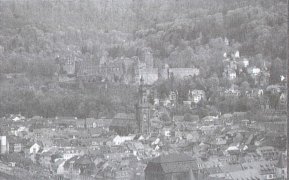
I must digress. This
adventure started way back in December of 1999, when Perianne spotted what she
claimed were Gingerbread boys as we traveled along the main road through
Soufflenheim, trying to find a parking place. On a spur of the moment whim on a
dreary Sunday, we had decided to go somewhere despite the bleak overcast skies
(a fact one lives with here in Germany during the winter months). So, of course,
the pottery town of Soufflenheim, France was the obvious choice. And as in all
quaint old towns in Europe, there are but narrow winding streets and always
someone in a hurry right on your bumper and never a place to pull over. So! When
we finally got to a parking spot several blocks away, the initial impatient
driver was gone, replaced by another speedster. Oh well, our license plate tells
it all with "USA" boldly stamped for all to see. This covers for a
multitude of driving blunders (or is it terror of what we will or will not do)
and courtesies as well.
We walked back into the shopping area trying to see any
evidence of the Gingerbread boys, but we could only see a pair of emerald green
gems (CD 550-570s) standing out on a bracket attached to beautiful house. Peri was sure these were not the insulators she had seen, but we could not see any
others. I cannot tell the CD 550 to 570s apart from the ground so we refer to
them as "groove tops".
It was about three weeks later when my brother
was visiting Heidelberg on leave from his tour in Bosnia that we again sped into
Soufflenheim. At the only stoplight in town, Peri asked if we could go straight
and try to find the Gingerbread boys. This was another dreary day under slight
drizzle, which accounted for no one else on the road. And then Peri piped up,
"There they are, I knew they were there". I was able to lurch the car
onto the curb, which doubles as parking. We all stared up at the four emerald
boys waving at us from their airy perch silhouetted against the gray sky high
above on a three-foot iron mast jutting from a beam on an abandoned building.
The building was really an extensive abandoned factory and this section had
burned. The little shop in front of the insulators was only open on Saturdays.
So, the next free Saturday we were back (this is three times now). Syndia began
the conversation with the shop owners in French and we concluded in both German
and French with just but a word or two of English. The shop owners were very
friendly but could only tell us who owned the building and gave us a phone
number.
We came back again the next week to meet with the now former building
owners, they had just sold the building. We were having trouble finding a
building number and Syndia went in an office we hoped was indeed the correct
building. Syndia spoke with Sylvia who was most helpful and we set up a time to
meet with the building owner who came into town on Fridays.
There was the
break-in at their business, which meant a delay of two more weeks and then the
fruitful conversation described earlier between Syndia and Sylvia. OK!= This
made the fifth time we had made it into France just to track down these little
lads awaving. I had a rare day off which made the timing even better but the
girls were all tied up. I had all my tools already packed and the fuel tank
full. So I was off - solo. I know only about seven words of French. It is
fortunate that Soufflenheim is just an hour away. When Sylvia took me to the
office chief they had to switch to German. There was a bit of concern with the
ladies about my safety, climbing around on the burned out portion of the
building. I had to use all the charm my German would allow and how being safe
was really important and they would not be responsible if I got hurt. I was
sure glad I had made those word lists of building materials and safety for the
troops coming over here. So with a bit of motherly trepidation the boss agreed
to open the building complex up and let me try to get the insulators.
The
section of the building complex was at least two stories tall with lots of shelves, mostly full of dusty pottery stacked all over. There was a
climbing spot next to a large pillar so up the shelves I went and was up nine
feet in a flash. I then moved to the burned section and on my hands and knees
moved along under some more shelves. These wooden planks were once of solid oak
but the bottoms had been scorched during the fire and as I got closer to the
wall the damage was greater. I spread my weight over three and sometimes four
boards and kept watching the boards bend a tiny more as I got closer to the
wall. I had called down a little earlier that all was well. I was glad she had
not asked me now. The horizontal beams in the wall were really burned and I realized this was going to be a dirty chore to get through and around the beams
in the open hole in the sheeting boards where they had fallen or completely
burned off. Luckily, this hole in the wallboards was right below where the post
was attached to the roof beam as well. It took some real wiggling to get on the
outside of the wall, feeling the charcoal slowly crunch under my weight and
hanging on to the harder parts and as I looked up I saw the mast above me. So
now came the excitement of holding on, getting the wrench to the correct size
and holding on all at the same time with one hand for each task (I would have
preferred to approach each task with two hands for sure). The first nut started
to twist then the entire bolt simply snapped. There was only a thread of metal
left in the five eighths inch bolt. The other bolt was still solid but the nut
on the other side of the beam would require over 6 inches of threads to unwind,
and then what would I do with the mast? I had one hand on the vertical beam
holding me on high and the other had the crescent wrench, so I needed another
arm or a sky hook to loop a rope over to keep a 40 pound piece of steel from
crunching to the ground. The emerald buddies were looking a bit worried too (or
so I hoped they were) but I was looking out for their welfare. This situation
required a different plan. There is nothing like making it up as you go. So I slowly undid a few threads of the upper nut then pulled the entire mast toward
me until and it bumped into a rafter jutting out of the roofline. At this
juncture I could see the elements had completely welded the bolts holding the
individual cross arms to the mast. There would be no unbolting the cross arms
and getting the insulators off at a more reasonable height, like on the ground.
From a previous insulator adventure in the same town earlier in the summer, I knew that the French had devised a system of using a pike-like iron peg with a
dime sized paddle on the end that was attached to either a cross arm or a
bracket for two insulators. They then attached the insulator to the pike with a
few tablespoons of gypsum. The insulators themselves are threaded and how the
French came up with this holdfast scheme is a prime feat of French engineering. I
moved to my left a bit, got a new handhold on another post and reached up to
twist the first and closest emerald boy off his iron perch.
Darling Mother Nature had taken her toll on the gypsum too because the
insulator at first just barely wiggled, then turned, and then it was free. I put
this first beautiful gem in my bag and reached back up for a second then the
third. My heart was pounding like a drum and the smile on my face was frozen.
The fourth piece was out of reach at my present perch so I had to go up a bit
higher on another horizontal beam, crunch some more charcoal hand holds and
extend the full length of my 73 inch height and begin to wiggle the piece.
Needless to say, the adrenaline level was still high in the veins but the
muscles were now really squawking. Back and forth and around and around my last
buddy turned, it was free but I needed just one more centimeter to lift it over
the paddle and into my already fully extended fingers. I felt like Katie on toe
during her ballet practice. But my shoes did not have a hard toe; they were just
grinding into charcoal. I took a deep breath and held it and somehow the arms,
the legs, and the vertebra stretched out just enough to let the fingers lift and
grasp the last Gingerbread boy over the pike and into a clutching clamp like
grasp. (Fear of falling at this point was not even a thought; the mind is so
oblivious to danger at times). I looked down for the first time, wow. So I
crawled back inside the building. Coming back across the burned out section was
still dicey but I had the lads in the bag and going slowly out to the good
boards was just fine. My heart was leaping. This adventure was coming to a
wonderfully successful end.
The gracious office chief who had let me into the
complex was much relieved to see me down in one piece and smiled at how dirty I
was. I know she was thinking those "Crazy Americans". I thanked her
profusely in both German, French, and English. And so we departed, I to the
community toilet to wash up a bit for the ride home and she to her home to have
lunch.
These emerald green Gingerbread boys are CD 640, ISOREX / 35/3/. Lovely
pieces.
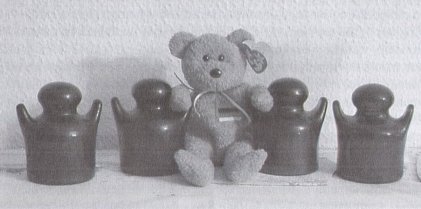
The wonderful Soufflenheim Gingerbread Boys Quartet
with their new buddy
Germania.
Earlier that summer, we had made our very first foray into the wonderful town
of Soufflenheim. It seems that this was the third hottest day of the year and we
were out stomping around to all the shops we could find and admiring the
beautiful pottery items and the centuries old town. We were hot and wanting a
drink, but we wanted to find this one last shop. We were following the arrows
down this nameless narrow street and Syndia was leading us as my eyes went up
along the old building for insulators. There were quite a few white porcelain
pieces in several styles. We spied the shop tucked away between some old
buildings that looked rather derelict. But alas, the shop was closed on this
afternoon. On the way back to the car I again focused my attention to the eaves
and backs of buildings looking for gems.
I stopped dead in my tracks, with Peri
or Katie stumbling into me. Under the eaves were two purple groove tops on an
iron bracket. Needless to say, I got a bunch of pictures (forgetting the heat
and the parched throat) and began pondering the possibilities; they were only
some 25 feet up the wall, there were only two bolts, there was a fence.... when
en masse the girls drug me away to get something cool to drink and a bathroom
break.
We came back the next day and got directions to Beck's pottery, owners of
the building. His new factory was just out of town. After an hour of driving out
all three roads from this part of town we were still not at Beck's. We had
trundled through some magnificent little villages with tons of beautiful
insulators on roof tops and even caught two Gingerbread boys hiding under the
eves above a butcher shop. We came back once again to our starting point and it
dawned on us that the directions we had assumed we would leave the shop to the
south when in fact we had left in the opposite direction. So a left turn at the
end of the street sent us down the wrong road and off to some distant village,
so we turned ourselves about and within a few minutes found the factory, not but
400 meters out of town. Oh well, we had some great pictures of different
insulators that we do not see in Germany.
Syndia got to talk with the young desk
clerk who was a bit confused. Finally Monsieur Beck came in to the show room and
he seemed to know about collecting insulators and knew about the ones in
question. I made the blunder of saying a few words in German and now there were
three languages going. Mr. Beck spoke fluent French and German (as does nearly
everyone in the Alsace region we are finding out) and pretty good English as
well. He was enjoying the break in a Monday routine. He asked us to come back on
Thursday and he would have someone assist us in getting the insulators down.
I
was able to escape from work for half a day off on Thursday to go back for the
glass gems. I had been resisting going into France for some unknown reason and this was our third trip in four days. I was hooked, at
least on the Alsace region. Mr. Beck greeted us at the appointed time, roared
off for a few minutes, and told us it was too dangerous for me to use a ladder
up so high, but not to worry. He went into the warehouse and in a few minutes
out putted a forklift with a large metal basket on the tines and two smiling
gents who had to get a look at these crazy Americans. So we drove off into town
following the forklift.
At the building, Pascal rode the basket up and took a
hammer to the stucco wall, then unscrewed the bolts. Gilbert was keeping a
careful eye on this from the controls in the forklift. They were just about as
happy as we were when they finished the removal and handed the gems over to me.
We thanked them with words and by taking several pictures.
We went back to Mr.
Beck's factory and thanked him in all three languages, the young clerk got a
chance to see what we had been talking about, and we left them fully knowing
Americans can be really crazy (but harmless). The insulators turned out to be CD
546s marked with "VA". They are a beautiful purple.
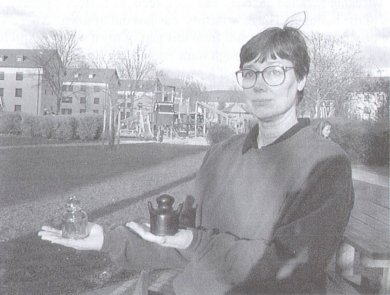
Syndia with a purple CD 546 and a olive Gingerbread boy (CD 640).
I have soldiers in the unit on the insulator search mission as well. One
young captain brought back brown and whitish porcelain pieces and a clear
Hemingray 45 from the sands of Egypt. The Hemi is dated 1942. These insulators could have been put up shortly after Rommel left Egypt. If only
the insulators could talk like the lines attached to them could, what kind of
tales would they tell?
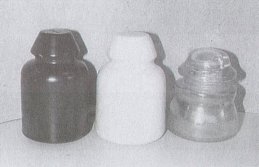
While stationed in Montana we had an exchange student,
Maggie, whose family lives near us in Stuttgart. We visit our dear friends the
Flaks often. They brought me several beautiful pieces from their home in Poland.
Herr Flak and I go to the electrical yard near their home and salvage a box full of gems every so
often. I have gotten a few large ceramic pieces but mostly CD 470s made in
France and Spain and CD 600s made in Germany, and glass Johnny Balls in several
colors. I keep hoping to find the other styles made by Vegla, which is why I
keep going back to the yards.
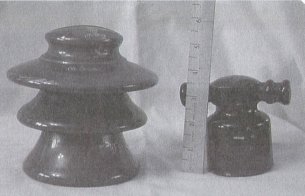
Several large ceramic power insulators which have been
added to the
collection. Size comparison to a CD 677.5 "t-bar."
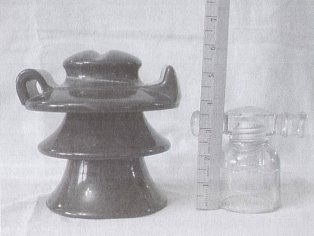
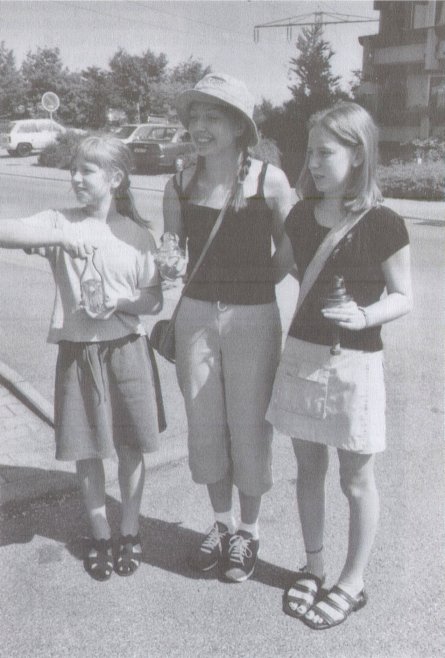
Perianne, Maggie and Katie after a successful hunt near Stuttgart.
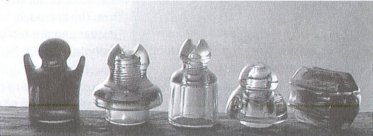
A CD 640, ISOREX 35/3, France; CD 600, VEGLA No. 95, Germany;
CD 546, V.A.,
France; CD 472, No Name, Poland;
a dark green glass "Johnny Ball",
Germany.
We had an opportunity to put some insulators on display at the library. So we
put in some of the glass we had brought with us and most of our new treasures
from Europe, a book or two, some simple descriptions of the hobby and
insulators, what causes color, and a small test on who could pick out the minor
differences in a pair of CD 470s. This sent the observer to the other display
case and many had to come back to check out the small ridge on the skirt. The
staff received so many compliments that they asked us to leave the display up
for another month. Now all our color and styles are back on our one small
display shelf made from driftwood we collected along the shores of Lake Michigan
while stationed at Fort Sheridan.
There are many jewels that have escaped
however. I went on a tour of Verdun, France with the engineer staff in February.
In Fort Duoumount, a fortress that cost the lives of many brave soldiers on both
sides of the trenches during World War I, the old electric lines were still on
the walls. On the sides of the darkened tunnels the rusting brackets hold three
ceramic insulators with the wires still attached. The fort was hollowed out from
a limestone hill and the stone they used for interior construction was coquina
(a rock composed predominantly of broken shells and coral bits). The hundreds of
thousands of shells that slammed into this hill put micro fractures through the
living rock and the building blocks. A bit of time and a lot of seepage is
making a beautiful new cavern with soda straw stalactites up to a foot long all
along many of the mortar joints and creamy blob stalagmites forming on the
floor. And the acidic waters are eating away at the metal brackets that hold the
white porcelain insulators to their task.
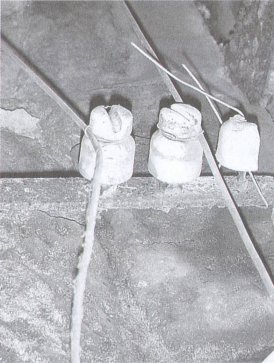
Acidic water corrodes the the brackets
of white porcelain insulators.
Every so often the insulators break free from the corroded bracket and are
left to freely bob about, held by a mere scrap of highly oxidized tie wire to
the insulated wire. And there was the Leatherman against my belt just itching to
get out. I had to settle for pictures.
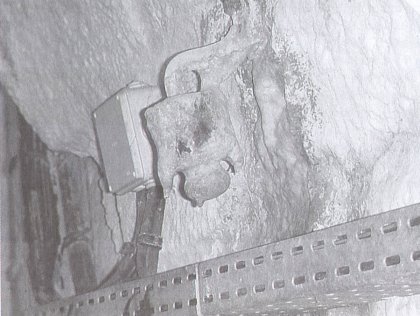
Stalactites forming on the head and arms of a Gingerbread boy.
The one gem that really caught my eye was
a Gingerbread boy. This piece was attached to a large metal bracket bolted in the rock about halfway up the wall. The bracket
had turned upside down and the poor lad has stalactites forming from his arms
and head. Not wanting to start an international incident (and not to mention the
unwanted attention of the general) I did not wish to be seen as trying to make
off with a trophy from one of France's holiest of war memorials but the poor lad
was in distress. So I did try to right the bracket so he would have his head up
to all the drips, but alas to no avail. So I tried to get a picture, but the
angles were not right, so in a moment of sheer artistic frustration I did
attempt to turn the lad around a bit, just to get a better shot of the limestone
forming on the head and arms you understand. Truly it was just for a picture
that I nearly sprained my wrists trying to turn the boy about. But limestone is
stronger than gypsum. So now you understand the reason behind the topsy-turvy
quality of the picture.
I saw my first wild "T-bar" on a wall in the
city of Verdun and lots of lonely groove tops as well. The family is going there
soon and Syndia will get to practice her charm and French too.
So the adventures
go on. The girls are used to the wild stops and picture taking in some small
town or railroad or almost anywhere. My boss and I run nearly every day and he
has gotten good at grabbing me before I crawl up the side of some old barn or
gasthaus in downtown Heidelberg, or while touring Venice (where green glazed
double petticoats
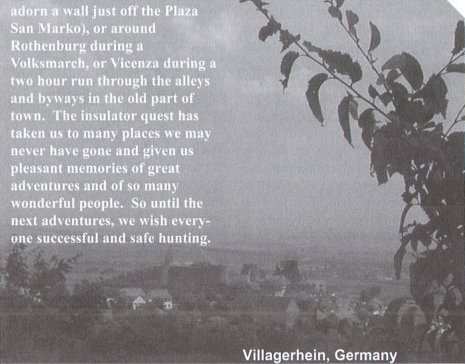
| 